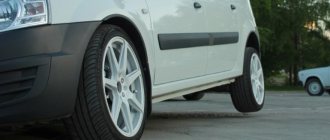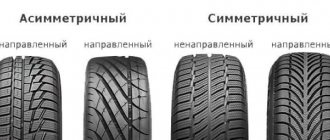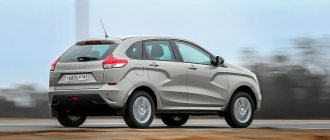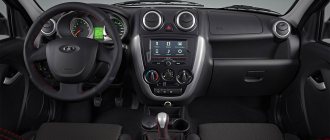A tire is not just rubber that softens the passage of uneven surfaces, but a functional design characterized by a complex structure. It ensures wheel traction on any road surface, effective braking and realizes the traction characteristics of the engine. Tires affect the vehicle's maneuverability, fuel consumption and the noise level created by the vehicle.
Wheel sizes of Lada Largus
The size of the wheels affects not only the appearance of the car, but also how it will behave on the road. AvtoVAZ indicates only one wheel size for the Lada Largus - 185/65 R15. Wheel parameters:
- 6Jx15;
- ET (departure) - 50;
- the distance between the holes for fasteners (bolt pattern) is 4x100.
Exactly the same size is indicated for Renault Logan, from which most of the components and parts for Largus were borrowed. In addition to this size, it is possible to install others:
- 185/70R14;
- 195/65R15;
- 205/55 R16;
- 205/50R17.
When choosing, keep in mind that the wheel size should not differ significantly from the standard one. Installing larger rims and tires may negatively affect the operation of the ABS and ESP systems, and their calibration will be disrupted.
Acceleration and traction characteristics are affected by the weight of the wheels - the lower this value, the faster the car will accelerate and the better it will hold the road.
The situation is different with the Lada Largus Cross in the back of a van. This model is equipped with wheels with a radius of R16 from the factory; all other parameters (offset, bolt pattern) are the same.
What parameters and characteristics should you pay attention to when choosing tires for the Lada Largus Cross?
When choosing tires for the Lada Largus model, you must follow the dimensions presented below for both the tires themselves and the wheels.
Recommended tire size:
As for disks, the parameters and sizes for them are as follows:
- Disc bolt pattern - 4×100.
- Rim width - 7.0J, inches.
- Rim offset - ET 40, millimeters.
- The diameter of the centering hole is CO 60.1, millimeters.
In the factory configuration, the Largus version is equipped with 14, 15 or 16-inch wheels. For the “Cross” version, only 16-inch wheels are installed. You can choose winter tires for this car without much difficulty, the main thing is to comply with all the required dimensions.
This is not a problem, but it might come in handy for someone. The question arose about the size of tires for the winter. On the website, many write that 205/60/R16 fits without problems. Well, on the Largus Cross this size looks absolutely perfect. Moreover, in my opinion In my opinion, this size on the Cross should be stock from the factory.
Yesterday I tested the tires especially for RUSTEM50. And unfortunately I must note that there are problems (If you twist the steering wheel all the way and try to turn sharply, the rubber catches on the fender liner, not much, but there is a characteristic sound. Otherwise, jumping over police officers and combing have not yet noticed any problems .Now we have a thaw, but as soon as the snow porridge appears, I’ll test for frozen ice under the fender liners and report back.
The LADA Largus car quite confidently won the hearts of lovers of the domestic brand. Largely due to the good quality of workmanship, reliability of the units and significant capacity not only in the cabin, but also in the luggage compartment. Maintenance of the car is simple; in particular, the range of winter tires on the Lada Largus will pleasantly surprise you with the variety of manufacturers and a wide range of sizes. This article will go into detail on this topic with several recommendations for choosing tires.
Selection of tires for Lada Largus
AvtoVAZ equips configurations above the base with Continental Premium Contact tires, but usually only for summer ones. For this reason, owners have a question about how to choose summer, winter or all-season tires for their car.
Selection of summer tires
Tires must match the wheel size. When choosing, the speed and weight index, brand and tread pattern are taken into account. The production date of the tires plays an important role - if they were made more than 5 years ago, it is better to refuse such a purchase.
Tread pattern
There are three types of patterns: asymmetrical, directional and symmetrical. The latter is the most popular, as it is considered universal and fits most cars. This is the best option for everyday driving around the city - without racing or off-road use. The main reason for choosing this design is its affordable price. Tires on Lada Largus with a symmetrical pattern are cheaper than all others. Such tires also have disadvantages - poor handling at high speed and wet asphalt, problems with sharp turns.
The directional tread pattern copes well with moderate off-road conditions and drains water well, showing normal handling and stability on wet road surfaces. The disadvantages include excessive noise, they cannot be placed on different sides due to strict direction, soft edges of the tread reduce directional stability.
The asymmetrical pattern shows the best characteristics: good directional stability, reduced risk of aquaplaning, you can swap wheels if necessary, increased controllability at high speed. The only drawback is the high price.
Profile height
If it is not possible to change the rims, it is recommended to install a standard tire size. Many owners strive to improve the appearance of their car. The most obvious way to do this is to install larger wheels, and this will require appropriate low-profile tires.
With a profile height of more than 60%, it is not advisable to use the car on the highway - such a tire is suitable for poor road surfaces and softens all unevenness. For driving on asphalt, it is better to use low-profile tires, as they improve dynamic performance and handling. But ride comfort is reduced - every bump will be reflected in the suspension.
Winter tires
When choosing winter tires, a lot depends on the budget, because there are European, Japanese, Chinese, and Russian brands on the market that produce tires in different price segments. For Lada Largus, it is recommended to use standard tires recommended by the manufacturer in winter. All that remains is to choose between studded and non-studded.
Handling when driving on snow is affected not by the presence of studs, but by the tread pattern. The pattern of studless rubber should contain many rectangular blocks arranged in a checkerboard pattern. The tread depth is also important - it should be at least 8 mm. The lamellas provide good grip on winter roads. Studless tires are often called “Velcro.” This is an ideal option for regions with mild winters, where ice and temperatures below 5 degrees are rather an exception. For wet snow, a tire with a directional tread pattern is suitable, as it drains water well. Advantages of studless tires:
- suitable for use on wet and dry road surfaces;
- does not make noise;
- does not have a negative impact on the road surface;
- It is resistant to high temperatures and does not impair controllability.
The main disadvantage of studless tires is their unsuitability for use on icy road surfaces. On ice and compacted snow you cannot do without tires with spikes.
The more studs on the tread surface, the better the grip on the winter road - slipping will be reduced, and the braking distance will be significantly reduced. But such tires also have their drawbacks:
- not suitable for wet snow;
- on dry or wet asphalt, the braking distance increases and the risk of skidding is higher;
- on loose snow they will not help the car to leave, but on the contrary, they will bury it even more;
- increased noise on asphalt;
- Fuel consumption increases slightly.
Despite a large number of shortcomings, it is the studded tires on the Lada Largus that have gained the greatest popularity in the middle zone and in the north, where weather conditions do not allow the use of other types of tires.
Selection of all-season tires
The niche of universal tires is occupied by all-season tires. For the most part, such tires are produced with an asymmetric tread pattern. The inner side has a rectangular pattern and is suitable for driving on snow, further increasing traction on icy roads. The outer side has a V-shaped tread, which allows you to effectively remove water from the contact patch between the tire and the road. "All-season" cars come in different types. The most popular are tires adapted for use on asphalt in the summer, but for winter roads this is not the best option. There is no point in considering off-road tires - they cannot be used on Largus, although they are considered universal for winter and summer.
On all-season tires you can find two abbreviations - All seasons or M+S (Mud+Snow - mud + snow). But these designations do not constitute official confirmation of the possibility of use in different conditions. The advantages of “all-season” tires include:
- savings - no need to buy a summer and winter set of tires, especially important if the car is not used year-round;
- the price is lower than that of specialized tires for a particular season;
- in mild winter conditions they show better performance than special kits.
This is where the advantages end; such wheels have many more disadvantages. Their main drawback is that they are equally functional in both summer and winter, losing out to seasonal products in many respects. Most of these tires are not recommended for driving at high speeds; their cross-country ability also suffers in different conditions.
All-season tires wear out quickly; buying a new set every two years is standard practice. Summer and winter sets can last 3-4 years, and with measured movement - even longer.
In harsh winters and icy conditions, driving on such wheels is unsafe and increases the risk of getting into an accident.
Renault Logan wheels
Thanks to its good quality and reasonable price, this car has become very popular in Russia. Its design is simple and reliable. But, the time comes and any mechanism breaks down and requires replacement. The same thing happens with disks - many years of use take their toll. The question of replacing them arises due to wear and tear or the owner’s desire to improve the appearance of the car.
What kind of wheels were installed on different bodies and configurations?
15 years have passed since the release of the first Renault Logan car, and during all this time the car has changed only once. Despite the fact that the first modification has already been discontinued, there are still a huge number of 1st generation cars on our roads, which indicates the popularity of this model.
The wheel rim dimensions also remained the same, with the exception of some additions, in particular, some parameters have changed:
- The bolt pattern of all models is identical, and the wheels on a Logan car are screwed through the central hole using four connecting pins. The hole diameter is 60.1mm;
- The basic car is equipped with 5.53x14 ET43 wheels. The tires used for them are 185/70 R14;
- Renault Logan, different from the basic configuration, is available with wheels with a radius of R15, which are designated 6.03x15 ET43. In this case, 185/65 tires are installed.
These characteristics are common, which makes it possible to use wheels for Renault Logan from such car models as Daewoo Lanos, Kia Rio, Lada Largus, Renault Sandero and Hyundai Accent.
Some car owners don't like the basic size and style of the disc. Gradually they decide to replace it with another, more aesthetic one. For Renault Logan, you can choose wheels with a single central hole, but with a different radius (R):
- for the 14th, 5.5Jx14 ET43, as well as 6.0Jx14 ET38 wheels are suitable. Tires can be taken 165/80 or 175/70;
- For size 15 there is an alternative option 7.0Jx15 ET35 with tire width 195/60. This method is more suitable for Logan operating in winter conditions;
- The 16th dimension is not included in the basic package and allows you to install a smaller profile tire 6.5Jx16 ET35;
- and finally, size 17 is considered an exclusive model. The 7.0Jx17 ET38 alloy wheel with a 205/50 profile gives Logan a real sports car.
Standard disk sizes
The number of wheel modifications for the Renault Logan model is three models:
- 14x6.0: diameter 14" (35.6), width 6.0" (15.2);
- 15x6.0: diameter 15" (38.1), width 6.0" (15.2);
- 14x5.0: diameter 14" (35.6), width 5.0" (12.7).
- Reach (ET): from 38 to 50 mm;
- drilling (PCD): 4×100 mm;
- center hole (DIA): 60.1 mm.
Parameters of standard nuts
All three items have the same seats, for which standard bolts and nuts are used.
What kind of disks can be installed?
First, let's figure out what kind of disks there are. They are divided into several types:
Stamped. Inexpensive and most suitable for use. It is recommended to install the following disks on Logan:
- R14 (5.5H2 ET43 DIA 60.1 PDL 100×4) with 165/80 tire;
- R15 (6J15 ET50 DIA 60.1 PDL 100×4) with 185/65 tires.
Cast. The most popular, although expensive. The material used for manufacturing is aluminum or magnesium alloy. The design of the wheel rim is lightweight and very durable.
The only negative is the fragility of the product. Any significant impact can chip the disc, making it unsuitable for further use.
Forged. They are born using forging. The result is a very durable and lightweight product. Able to withstand getting into a deep ditch and even driving onto a curb at high speed.
The disadvantage of the disc, oddly enough, is the very strength of the product. The fact is that during a strong impact the material does not deform, and all the force falls on the suspension.
It is not recommended to mount a low-profile tire on a car; the car will only lose: a spoiled appearance and an increase in the noise effect when driving the Renault.
There are global brands, for example, Bridgestone or Hancock tires, which provide safety and quality.
Advice. The choice of wheels for a car should be done with special attention. In addition to design functions, this part affects comfort and safe movement, as well as the performance of the car’s suspension, which is affected by mechanical shocks during damage (potholes) on the road.
Factors influencing the choice of the right disk.
The wrong choice of disk can result in another breakdown of the car, so experts recommend adhering to the following criteria:
- Purpose of the model: When traveling on flat, open roads, you can install discs with a radius of 15 and 16. In cases of constant driving on country roads, where the quality of the coating is less than optimal, a 14th radius is used.
- Manufacturer. Quality comes first. The main thing is that the model is reliable and provides maximum safety.
- Product type. Select the type of disc (cast, stamped or forged).
- Selection by appearance. Not the first on the list, but it influences the improvement of car tuning.
To imagine what the vehicle will look like from the outside, it’s a good idea to look at photos of Renault Logan equipped with various wheels, presented on the Internet. This will speed up the selection of the desired sample.
Replacing wheels on Lada Largus
There are many reasons why you have to remove one or more wheels. This is a simple puncture, replacing brake discs or pads, suspension repairs, changing tires. Every driver, regardless of length and experience, should be able to remove and install a disc on a hub. The procedure is simple and can be done with your own hands. To change a wheel on a Lada Largus you will need a standard set of tools:
- jack;
- wheel wrench, can be replaced with a wrench with a 17 mm head.
For safety reasons, work under a vehicle that is supported only by a jack is prohibited. It is advisable to play it safe and add bricks, timber spacers and other suitable devices.
Replacement process
Using a 17 mm socket, you need to unscrew the fastening bolt that secures the spare wheel in the niche. For factory decorative caps - installed on stamped discs - you will need a special key for removal; it is included in the standard tool kit. After removing the hubcap, you need to loosen the wheel bolts using a wheelbrace. Next, the car is jacked up, the wheel bolts are completely unscrewed, and the disc is removed. Installing a new wheel is carried out in the reverse order. Forged and alloy wheels use different bolts.
Safety
The procedure for replacing wheels is not a complex operation, but even here you will need to follow basic safety rules. The vehicle must be on level ground and a hard surface. Wheel chocks must be installed under the wheels, and the machine is additionally secured with a hand brake. In addition to the jack, safety stops should be used - factory products are a priority.
DIY tire replacement rules
In order to save money, many car enthusiasts are thinking about replacing tires themselves. The process is not the easiest, but doable. To work, you will need a balloon, mounting blades, a jack and a compressor or pump. When performing the procedure, you should take into account some tricks, without which this event is doomed to failure.
Removing the tire from the rim
First you need to remove the wheel from the hub. Then it is laid on the ground so that the nipple nipple is at the top. All the air is released from the tube or tire, in the case of a tubeless tire, and the nipple nipple is recessed inside. You need to stand on the wheel with your feet so that the edge of the tire separates from the rim of the disc. Sometimes extra force may be required if the rubber sticks to the metal.
A mounting blade is inserted into the gap between the edge of the tire and the disk, then a second one. The main task is to turn the sidewall of the tire beyond the edge of the rim. If the wheel has a tube, it is pulled out through the resulting gap. If the tire is tubeless, you need to unscrew the entire side of the tire by the rim, then unscrew the second sidewall of the tire using the same edge of the rim and remove it from the rim.
When working, you must apply considerable force and be careful not to damage the disc. Cast products made from light alloy materials are especially fragile.
Mounting a tire on a rim
Before installation, make sure that the tire is the correct size and has no defects. It is recommended to remove the balancing weights and the old nipple. When installing, you should take into account the markings on the tire, usually the direction of travel in the form of arrows.
To facilitate the installation task, you can apply a soap solution to the edge of the tire and the rim of the disk, but within reasonable limits, otherwise the tire will slip. Installation is carried out in the reverse order of removal. First, one edge of the tire is put on, after which the second one is wound on the rim.











